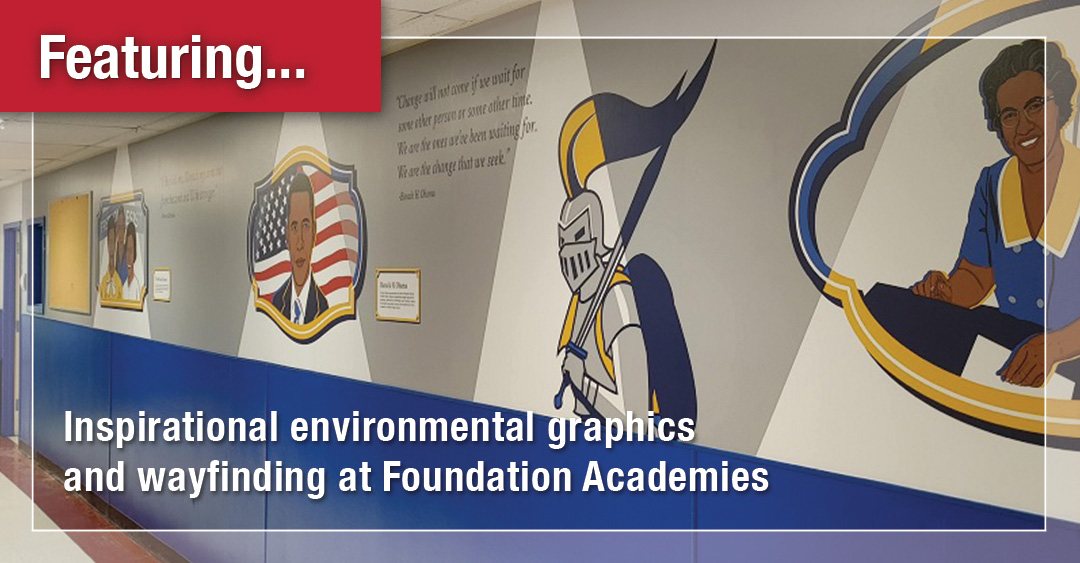In the spirit of great architecture that elicits a positive, emotional and seamless user experience, DIGroup Architecture recently marked the completion of its latest Graphics Studio assignment with the delivery of mission and values-focused environmental graphics and wayfinding signage on behalf of Foundation Academy in Trenton, N.J.
Tasked with capturing and illustrating imagination, vision, aspiration and education in creative and energetic ways, DIGroup created landmarks for guidance and visual experiences to educate and inspire students, staff and visitors. This is just one example of a DIGroup Graphics Studio-focused assignment and the in-house team’s important role in a multi-disciplinary approach to every project, from inception to completion.
“Understanding how an individual interacts with a space is just as important as the space itself,” said Director of Graphic Design Marina Stern. “DIGroup is raising the bar for evaluating the appropriateness of and incorporation of graphic design, wayfinding and signage wherever and whenever appropriate. Including an up-front plan for these important – yet often overlooked – elements ensures that a space successfully meets the needs of its users, makes sense and incorporates visual cues that are critical to navigating a new space.”
Founded on the principle of “Architecture for Change,” DIGroup’s enduring success is fueled by a talented team that includes specialized graphic designers tasked with shaping modern spaces to emphasize the human experience. Rather than creating spaces for clients based solely on form, aesthetic and blueprints, the firm’s professionals are committed to delivering spaces that are equal parts form and function.
According to Stern, designing for human experience requires understanding human behavior and is akin to how software developers approach their work in solving a user’s experience with a new app or website. Rather than create space that relies on aesthetic, DIGroup starts with the end-user in mind to ensure that the delivery of the end-product or service is adopted without barriers to entry.
One recent project in which all three of DIGroup’s service areas – architecture, interior design and graphic design – came together to achieve a custom integrated effect was on behalf of UNITI Cultural Center (UCC) at Stony Brook University. Occupying almost 4,000 SF, the UCC opened in late 2021 and was conceptualized to convey cultural diversity, inclusion and equity. In addition to its carefully curated vibrant mix of multicultural-inspired organic structures, furnishing, finishes and graphics, the UCC features prominent wall graphics highlighting people of color and meaningful quotes.
“Our team immersed themselves in capturing the essence of UCC’s multicultural energy, from texture and textile designs, weaving and basket making to elements associated with international festivals, celebrations and ethnic food trucks,” said Stern.
This same immersive approach to every assignment is what drives the DIGroup Graphics Studio team and feeds their curiosity during the discovery process with a client.
“We work collaboratively in-house and with our clients to make sure the product we’re delivering – whether it’s a new school, healthcare facility or community center – is utilized in the way the client intends and is designed in a way that our clients’ clients will experience it,” said Stern. “We’re asking questions like, ‘Who is the ideal user? What will they be doing at the facility? Where will they need to go?’”
In addition to providing an intuitive, logical interaction with a space, design elements can be an emotional catalyst, connecting users and community members to a space in a more intangible way. So, another question asked by DIGroup’s graphics team is, “How do we want a user to feel while they are in the space?”
For example, when DIGroup Architecture worked to create new facilities for Camden High School and Trenton Central High School, it was Stern and her team that created the plans and drawings that made it possible to achieve the New Jersey School Development Authority’s vision for interpretive installations that repurposed artifacts from the original structures.
“This team-based approach made these installations happen successfully by using graphic designs to tell the visual stories that educate and inform about each artifact,” said Stern.
For both the Camden and Trenton High School projects, a wide range of artifacts – columns, capitals, pediments and mosaics – were integrated into their respective replacement schools. In addition to earning the praise of end users, both projects garnered several local, regional and national awards, including special recognition from Preservation New Jersey.
“Ultimately, it is the design details that bring space to life,” explained Stern. “If people come into a new building and it’s not intuitive, doesn’t have the appropriate signage, or doesn’t feel psychologically soothing, energizing or safe, it is not going to be a place that people will want to spend time. In short, our mission is to create a space that feels familiar, warm and welcoming and graphic design, wayfinding and signage are an important piece of this puzzle.”

